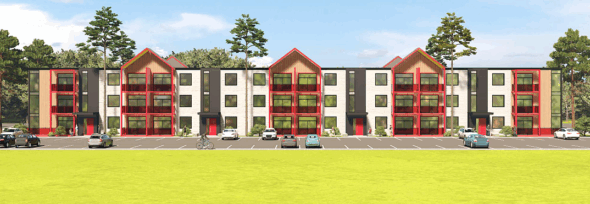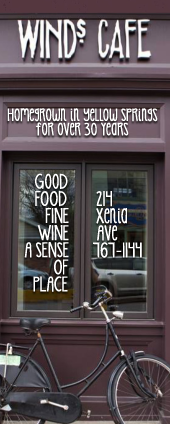
Columbus-based real estate developer Windsor Companies' newest plan for apartments at the site of the former Antioch College Student Union entails building a two three-story apartment complexes composed of 48 units each. (Rendering courtesy of Windsor Companies)
Village Council to vote on apartments at Antioch
- Published: July 5, 2025
Next week, a developer may be given the greenlight to take the next steps toward one day building several apartment complexes around the campus of Antioch College.
On Monday, July 7, Village Council will give second readings to and hold public hearings on four pieces of legislation: preliminary development plans for both the college’s former Student Union and the Charles F. Kettering building, as well as petitions to rezone both sites from educational, or E-1, to planned unit developments, or PUDs.
As previously reported in the News, Columbus-based real estate developer Windsor Companies aims to demolish the derelict Student Union and, in its place on the 2.16-acre site, build two three-story apartment buildings, with 48 market-rate rental units in each. Windsor purchased this property from Antioch last summer for $500,000.
As for the Charles F. Kettering building, which is on 1.25 acres and is the current headquarters for 91.3 WYSO, Windsor plans to preserve the building and adapt it for senior living, installing 43 rental units for those 55 and older. Unlike the former Student Union, the college still owns the Kettering building; it’s listed as under contract.
Windsor had initially proposed building 128 units at the Student Union site, but following some push-back from local residents who attended a recent Village Planning Commission, the developer reduced their plans for that location to 96 units.
With unanimous votes over two meetings in May and June, Planning Commission members recommended approval to Village Council for both Windsor’s plans.
Should Village Council approve the requests to rezone both properties as well as Windsor’s preliminary development plans, the developer will have exactly one year to craft their final development plans and submit them for additional Council approval.
During that time frame, Windsor would have to include the Village’s five recommended conditions into their site plan:
• Conduct a traffic study, and incorporate the findings and engineering recommendations;
• Build sidewalks around both locations;
• Create bicycle parking at both locations;
• Devote 15% of the total number of dwelling units to affordable housing; and
• Conduct a stormwater management plan.
At the former Student Union site, Windsor aims to create 110 parking spaces, and at the Charles F. Kettering location, 52 spaces.
According to Village Planning and Economic Development Director Meg Leatherman, if Village Council members approve both Windsor’s preliminary development plans, and Windsor finds they must modify their proposals, the developer cannot increase the number of dwelling units, nor can they decrease the number of proposed parking spaces.
“In submitting the final plat plan,” Leatherman told the News in a recent interview, “Windsor will have to make whatever Council approves work. However, the number of parking spaces can go up, and the density can go down — as long as it’s not considered a substantial change.”
In other words, if the results of Windsor’s future traffic studies reveal that additional parking spaces are needed, or if Council members make such a request themselves, then the developer may have to cut into the number of proposed apartment units.
If those “substantial” changes must occur, Leatherman said, then Windsor would likely have to revisit the Village Planning Commission with an entirely new preliminary development plan, thus restarting the municipal approval process.
Also at stake with Windsor’s plans to build its apartments is the leveraging of Community Reinvestment Area, or CRA, dollars which, according to Village documents, would set in place a 15-year, 75% property tax abatement.
As Leatherman told the News, any public finance incentives offered from the Village to Windsor, such as a CRA or tax-increment financing, would ultimately have to go through Village Council approval at a later date, pending their approval of Windsor’s site plans.
Neighbors air density, process concerns
Last month, the News sat down with a handful of villagers whose homes — mostly on Davis, Whiteman and Livermore streets — abut Windsor’s proposed complexes.
Their message was clear: Windsor is asking to build too many apartments on too little land, and that added residential density may create traffic and safety problems and disrupt the neighborhood.
“We’re not opposed to apartments, but we want something more to scale,” Desiree Nickell said of the proposed 96 units at the Student Union site. “This could be the most dense, biggest apartment complex in Yellow Springs.”
Should Windsor actualize its plans and gain Council approval, Nickell would be correct. Hawthorne Place — the current largest apartment complex in Yellow Springs — has 52 units sited on 3.28 acres; upon completion, the senior-focused Cascades neighborhood will have 32 total units on 1.8 acres; and the Twin Coach apartments contain 24 units across 3.5 acres. As it stands, Windsor aims to site 96 units on just over two acres.
“This is a different sort of neighborhood,” Nickell said. “We’re not an urban district where you can build up as high as you want.”
A plan for the Student Union site to which Nickell and her neighbors would be amenable is one with fewer units and reduced structure height: The neighbors said they beseech Windsor to build just 64 rental units — that is, two two-story buildings with 32 units each.
Multiple attempts from the News to reach Windsor for comment ahead of press time were unsuccessful.
At an earlier Planning Commission meeting, when posed with a similar question about reducing the number of units, Windsor partner Erik Alfieri cited potential “challenges” in securing bank loans to finance construction of a complex with too few units.
Neighbors of the proposed apartment complex at the former Student Union site were also united in their trepidation over the potential traffic and parking problems — particularly those that may result from Windsor providing an average of just over one space per rental unit, which may spur tenants to park on the street in the surrounding neighborhood.
“In Greene County, the average car ownership is two cars per household,” Villager Tom Degenhart pointed out, citing statistics he gathered from Data USA.
“Of the people in Greene County 71% drive alone to work, 11.6% work from home and only 6.9% carpool,” Degenhart continued. “This means that most people who live in these apartments will have more than one car, and will be commuting to and from work every day.”
Further rejecting previously made claims from recent public meetings that future tenants won’t be car dependent, Moria Laughlin said, “There just aren’t enough businesses in town for everyone who lives here to walk to work — they’ll have to drive out of town.”
Whiteman Street resident Jerry Papania added: “And people now have to drive out of town for a good pharmacy, and to go to a hardware store.”
To help decongest and mitigate this potential traffic flowing through the neighborhood, the neighbors had a straight-forward proposal: the reopening of the once-existent stretch of E. North College Street that, until it closed, connected Livermore Street to Corry Street.
Though the News was unable to determine when that section of the road officially closed to vehicular traffic — some Antioch alumni anecdotally relayed memories of it being open to vehicle traffic in the ’70s — county data indicate that ownership of the road transferred hands from Village government to Antioch College in 2015.
“It’s absolutely essential they reopen the street — regardless of how big this is,” Papania said. “Windsor’s plans now have a parking lot entrance on Whiteman and Livermore streets — there needs to be one off E. North College Street.”
According to Planning Administrator Leatherman and Antioch College administration, discussions to reopen that street are underway.
“As a planner, I like connectivity,” Leatherman said. “The more points where we can walk clearly and safely, that’s what I like to promote.”
Should Antioch agree to relinquish ownership of the closed portion of East North College Street, that could mean vehicular traffic would intersect most of its campus and the student space in Weston Hall.
“The College is very open to conversations with the Village regarding plans for East North College Street,” Antioch Director of Communications Franchesca Smith said in an email to the News. “We would like to see the results of the traffic study and then proceed to a decision about the right-of-way.”
Smith added a caveat: “We are considering factors like student privacy and safety and the impact that having a road running through campus would have on students. Our goal is finding a solution that feels mutually beneficial for the college and village.”
Some neighbors to the Student Union site also expressed reservations over the Village’s handling of the municipal code’s allowances for PUD variances allotted to Windsor — namely the authorization to exceed the Village’s maximum density of 14 dwelling units per acre.
“We have zoning requirements for a reason, and the Village is giving [Windsor] a pass on a lot of them,” Degenhart said. “Will this mean that future developers can build as big as they want to?”
Per the local zoning code, the Village can offer density bonuses to builders, provided they create various on-site amenities in exchange; in this case Windsor agreed to build “cool roof technology” on its apartments, low-impact development practices for stormwater management, pedestrian access points on the property and others.
“I think that the PUD section of the code is intended for exactly this kind of project,” Leatherman said. “It’s set up to offset density with additional amenities and careful consideration of how developments fit in with the village.”
Leatherman also said that the particular location of Windsor’s apartment plans — that is, directly between a predominantly single-family residential neighborhood and a college campus with ample space — is uniquely suited for high-density development, such as what Windsor has proposed.
“In this location, there is a smaller number of directly impacted residential properties because it’s right next to Antioch,” Leatherman said. “There could be single-family units surrounding it in its entirety. That’s not the case here. The impact of this infill project is less than that of a project totally surrounded by homes.”
Leatherman and her colleague, the Village Planning and Economic Development Coordinator Aaron Arellano, were in agreement that they and the Village have done the best they could to satisfy the practical needs of the developer, Antioch and the surrounding residents like Nickell, Laughlin, Degenhart, Papania and others.
“I’ll say that working with Windsor and how much they’ve come to really appreciate the community has been reassuring,” Arellano said. “We see how successful they’ve been in their other projects, and if community members feel they need more parking … then the Village will provide for them.”
Leatherman added: “In 20 years, if there is a very bad parking issue in the area, and it turns into like it is during Street Fair, then the Village would need to play a role in solving the hypothetical problem.”
Both Leatherman and Arellano maintained the faith that possibility is unlikely.
“Maybe I’m overly optimistic, but overall, I think this will be good for the community,” Leatherman said. “We need more housing. Temporarily, during construction, this will impact people next door, but once it’s finished, this will benefit Yellow Springs as a whole.”
As for the neighbors — until Windsor lowers the density, they’re maintaining misgivings.
“This process has moved way too quickly with little consideration for us,” Nickell said. “It almost feels like we’re being held hostage.”
The next Village Council meeting — when the group will give second readings and hold public hearings regarding Windsor’s proposed apartment plans at Antioch College’s Charles F. Kettering and former Student Union buildings — will be Monday, July 7, at 6 p.m., in Council Chambers on the second floor of the John Bryan Community Center.
The Yellow Springs News encourages respectful discussion of this article.
You must login to post a comment.
Don't have a login? Register for a free YSNews.com account.













No comments yet for this article.